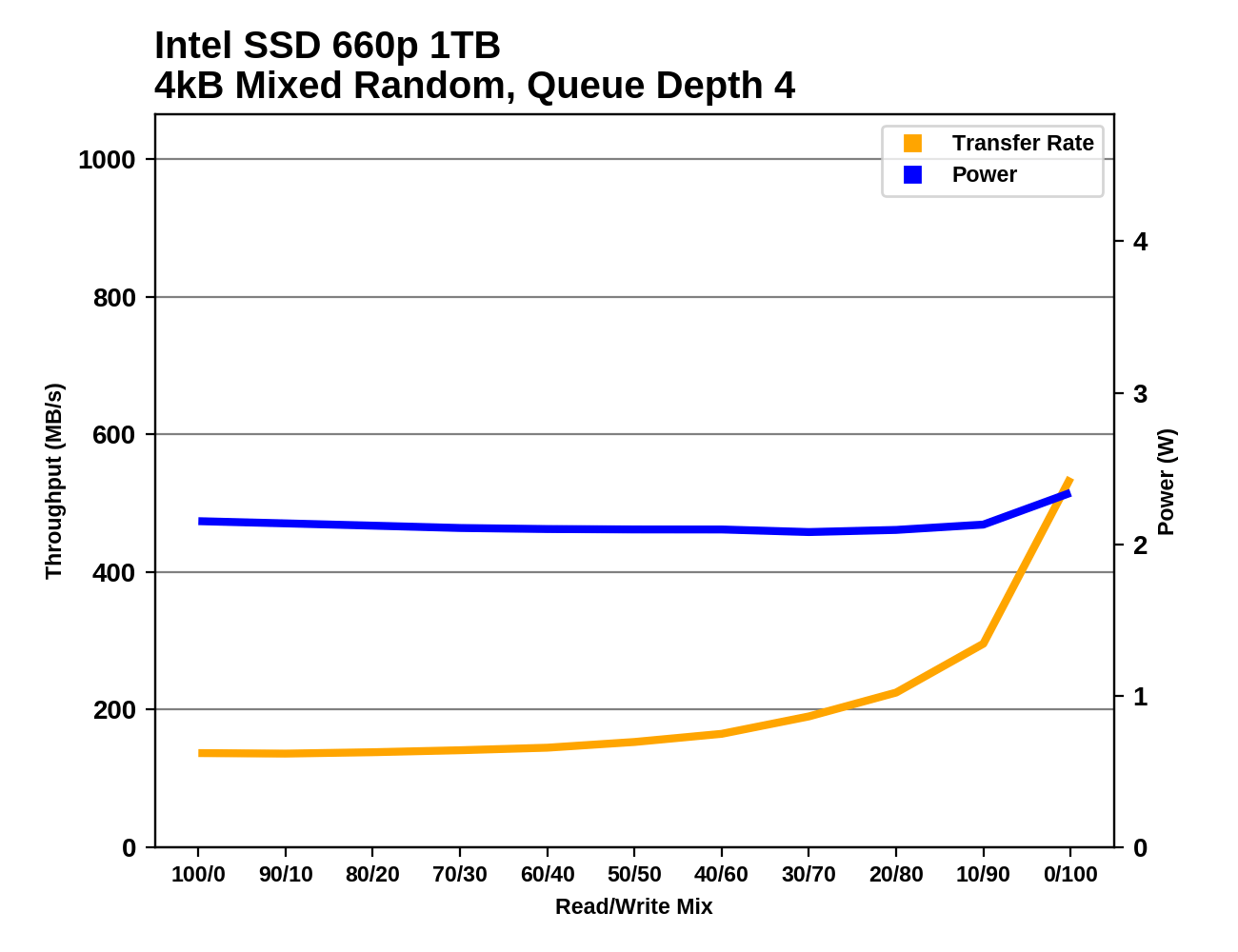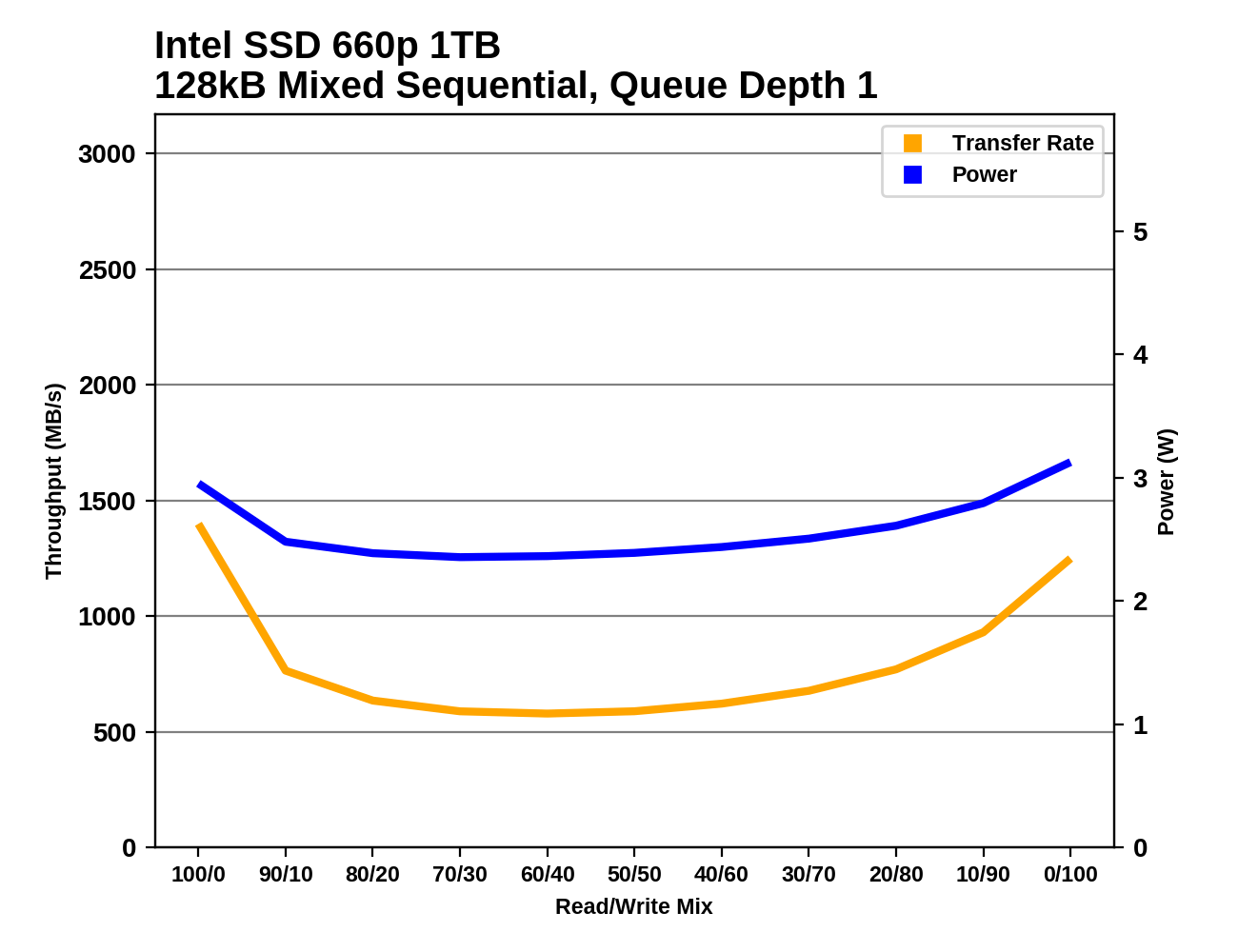The Intel SSD 660p SSD Review: QLC NAND Arrives For Consumer SSDs
by Billy Tallis on August 7, 2018 11:00 AM ESTMixed Random Performance
Our test of mixed random reads and writes covers mixes varying from pure reads to pure writes at 10% increments. Each mix is tested for up to 1 minute or 32GB of data transferred. The test is conducted with a queue depth of 4, and is limited to a 64GB span of the drive. In between each mix, the drive is given idle time of up to one minute so that the overall duty cycle is 50%.

The mixed random I/O performance of the Intel SSD 660p is clearly above the other low-end NVMe drives we've tested, or the Crucial MX500 SATA drive. It scores closer to a mid-range NVMe SSD. After filling the drive, performance is cut in half, leaving it performing near low-end NVMe drives like the Phison E8-based Kingston A1000 and below the MX500.
 |
|||||||||
| Power Efficiency in MB/s/W | Average Power in W | ||||||||
The power efficiency of the 660p during the mixed random I/O test is unimpressive but doesn't stand out as being significantly worse that other low-end NVMe drives even when the test is run on a full drive.
 |
|||||||||
The Intel SSD 660p shows very slow performance growth throughout most of the test, but it picks up speed reasonably well toward the end as the workload shifts toward pure writes, and the SLC cache handles things well. When the drive is full, the reduced capacity of the SLC cache prevents speed from increasing much.
Mixed Sequential Performance
Our test of mixed sequential reads and writes differs from the mixed random I/O test by performing 128kB sequential accesses rather than 4kB accesses at random locations, and the sequential test is conducted at queue depth 1. The range of mixes tested is the same, and the timing and limits on data transfers are also the same as above.

The Intel SSD 660p performs better than other entry-level NVMe SSDs or SATA drives when the mixed sequential I/O test is run on a mostly empty drive with a large SLC cache. After the drive is filled, performance drops down to slightly ahead of the 600p and Crucial MX500.
 |
|||||||||
| Power Efficiency in MB/s/W | Average Power in W | ||||||||
The power efficiency of the Intel SSD 660p during the mixed sequential I/O test is decent when operating entirely out of the SLC cache, and on par with most other low-end NVMe drives when the 660p is full.
 |
|||||||||
When the test is run on a mostly-empty 660p the performance shows a very typical bathtub curve and no sign of the SLC cache running out. When the drive is full, performance decreases steadily as the proportion of writes increases.










86 Comments
View All Comments
woggs - Tuesday, August 7, 2018 - link
2D nand was abandoned because it squeezed the storage element down to a size where it became infeasible to scale further and still store data reliably. The move to 3D nand took back the needed size of the memory element to store more charge. Cost reduction from scaling is no longer reliant directly on the reduction of the storage element. This is a key enabler for TLC and QLC.woggs - Tuesday, August 7, 2018 - link
Stated another way... Scaling 2D flash cells proportionally reduced the stored charge available to divide up into multiple levels, making any number of bits per cell proportionally more difficult. The the question of cost reduction was which is faster and cheaper: scale the cell to smaller size or deliver more bits/cell? 2 bits per cell was achievable fast enough to justify it's use for cost reduction in parallel with process scaling, which was taking 18 to 24 months a pop. TLC was achievable on 2D nodes (not the final ones) but not before the next process node would be available. 3D has completely changed the scaling game and makes more bits per cell feasible, with less degradation in the ability to deliver as the process scales. The early 3D nodes "weren't very good" because they were the first 3D nodes going through the new learning curve.PeachNCream - Tuesday, August 7, 2018 - link
Interesting performance measurements. Variable size pseudo-SLC really helps to cover up the QLC performance penalties which look pretty scary when the drive is mostly full. The .1 DWPD rating is bad, but typical consumers aren't likely to thrash a drive with that many writes on a daily basis though Anandtech's weighty benchmarks ate up 1% of the total rated endurance in what is a comparable blink of an eye in the overall life of a storage device.In the end, I don't think there's a value proposition in owning such the 660p in specific if you're compelled to leave a substantial chunk of the drive in an empty state so the performance doesn't rapidly decline. In effect, the buyer is purchasing more capacity than required to retain performance so why not just purchase a TLC or MLC drive and suffer less performance loss and therefore gain more usable space?
Oxford Guy - Tuesday, August 7, 2018 - link
The 840's TLC degraded performance because of falling voltages, not because of anyone "thrashing" the drive.However, it is also true that the performance of the 120 GB drive was appalling in steady state.
mapesdhs - Wednesday, August 8, 2018 - link
Again, 840 EVO; few sites covered the standard 840, there's not much data. I think it does suffer from the same issue, but most media coverage was about the EVO version.Spunjji - Wednesday, August 8, 2018 - link
It does suffer from the same problem. It wasn't fixed. Not sure why Oxford *keeps* bringing it up in response to unrelated comments, though.Oxford Guy - Friday, August 10, 2018 - link
The point is that there is more to SSD reliability than endurance ratings.Oxford Guy - Friday, August 10, 2018 - link
"few sites covered the standard 840"The 840 got a lot of hype and sales.
FunBunny2 - Tuesday, August 7, 2018 - link
with regard to power-off retention: is a stat estimation from existing USB sticks (on whatever node) and such, meaningful? whether or not, what might be the prediction?milkywayer - Tuesday, August 7, 2018 - link
My question is, should I truest this drive with valuable info if endurance can be an issue?If the PC is frequently powered On, will it refresh the cells?